Last Updated on July 2, 2025 by Chef skimo
From honey-soaked pastries to crisp filo pies filled with custard, Greek desserts are more than just a sweet ending—they’re woven into the very fabric of Greek life. Whether served after a festive meal or gifted during holidays, these confections blend history, culture, and indulgence into every bite.
In this comprehensive guide, you’ll explore the origins, recipes, regional variations, and modern twists of Greek sweets—plus expert tips on pairing and where to find authentic versions online.
Table of Contents
Why Greek Desserts Captivate the World
Greek desserts have found their way onto tables far beyond the Aegean. Their appeal lies in the perfect balance of textures—crispy filo against soft custards, chewy nuts against smooth syrup—and their celebration of natural ingredients like honey, olive oil, citrus, and spices.
In this guide, we’ll walk through:
- What defines a dessert as “Greek”
- Iconic recipes like baklava and loukoumades
- The influence of religion and holidays
- Healthier takes and vegan traditions
- Pairings with coffee, ouzo, and wine
- Where to buy them online and how to serve them at home
What Makes a Dessert “Greek”?
At first glance, Greek desserts might seem similar to other Mediterranean sweets—but a closer look reveals distinctive characteristics rooted in geography, faith, and simplicity.
Shared Mediterranean Traits
Greek sweets share common ground with Middle Eastern and Balkan desserts through their use of filo dough, syrup-soaked pastries, nuts, and aromatic spices like cinnamon and clove. However, the Greek approach tends to favor citrus zest, olive oil, and a leaner use of rich ingredients, often tied to Orthodox fasting practices.
Core Ingredients in Greek Pastry Tradition
- Honey: Used not just for sweetness, but for its floral aroma and natural preservation
- Filo dough: Paper-thin pastry layers used in everything from baklava to custard pies
- Olive oil: A staple in many fasting and vegan dessert recipes
- Nuts: Especially walnuts, almonds, and pistachios
- Semolina: A coarse wheat flour used in cakes and custards like galaktoboureko
- Citrus: Lemon zest and juice brighten many syrups and fillings
These ingredients are more than just components—they reflect Greece’s land, climate, and religious rhythms.
A Culinary Timeline – Origins and Evolution of Greek Sweets
Greek desserts are not only delicious—they’re historical artifacts, shaped by ancient rituals, trade routes, and religious customs. Their evolution tells the story of Greece itself.
From Ancient Offerings to Byzantine Banquets
The earliest Greek sweets were simple: honey drizzled over nuts, fruits, or dough. Dishes like loukoumades (fried honey puffs) date back to the original Olympic Games, where winners were offered them as symbolic “honey tokens.”
During the Byzantine era, desserts became more elaborate. Sugar began replacing honey in some recipes, and new techniques (like syrup soaking) were adopted from interactions with the Arab and Ottoman worlds.
Influence of Ottoman and Venetian Rule
Greek desserts such as baklava, kataifi, and galaktoboureko were heavily influenced by centuries of Ottoman rule, while Ionian island sweets show Venetian touches like creams and jams.
Modern Adaptations and Global Reach
Today, Greek desserts continue to evolve. Chefs are introducing fusion pastries, plant-based versions, and visually stunning presentations—all while preserving traditional flavors.
From ancient Olympic feasts to modern Greek bakeries abroad, these desserts carry a legacy that’s both time-honored and ever-evolving.
Classic Recipes Everyone Should Know
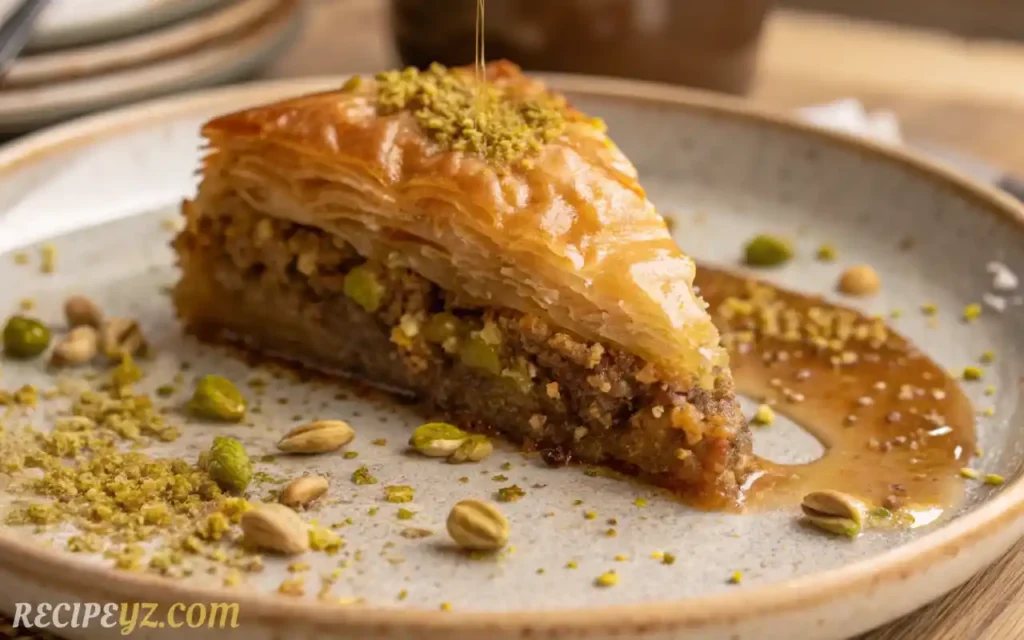
Certain Greek desserts are so iconic, they serve as culinary ambassadors for the entire culture. If you’re just beginning your journey into Greek sweets, baklava and loukoumades are the perfect place to start.
These two classics showcase the essential techniques and ingredients of Greek pastry making—filo layering, syrup soaking, and spice balancing—while delivering distinct textures and flavor profiles.
This modern chocolate sensation takes inspiration from traditional Middle Eastern sweets like baklava, featuring layers of rich flavors and textures.
The Must-Haves:
- Baklava: A rich, nut-filled filo pastry soaked in honey-lemon syrup
- Learn how to layer filo and pour syrup perfectly in our guide:
- → How to Make Authentic Greek Baklava at Home
- Loukoumades: Fried dough balls dipped in syrup, often topped with cinnamon and nuts
- Light, crispy, and rooted in ancient history
- → Greek Honey Puffs Explained
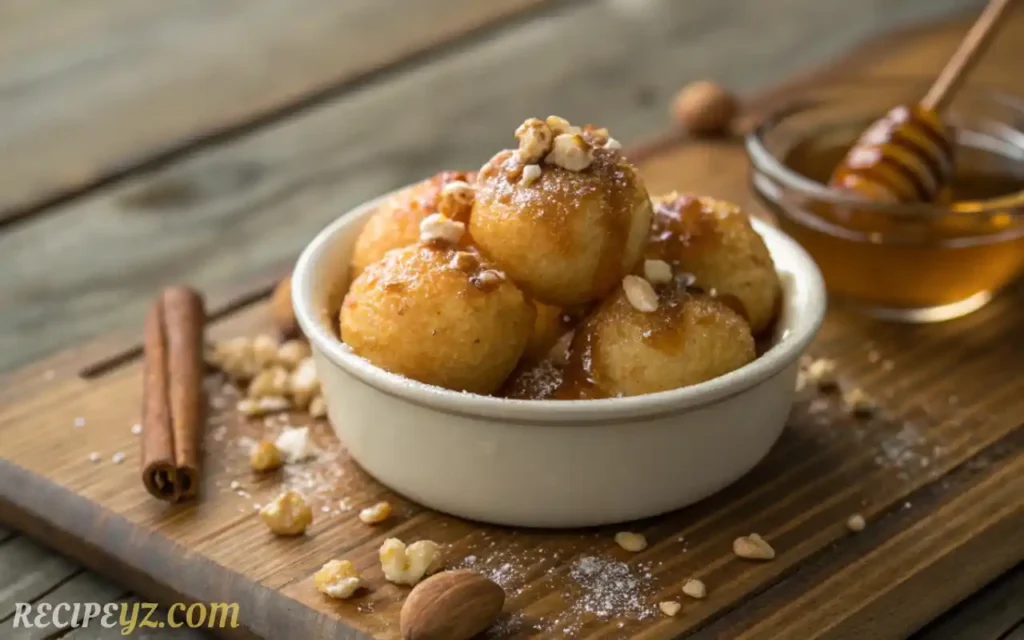
These recipes are more than delicious—they’re cultural mainstays, often passed down from grandmothers or served at festive tables.
Further Exploration
These two classics anchor our Classic Greek Dessert Recipes cluster, which also includes serving tips and variations.
The Custard Family – Galaktoboureko, Bougatsa & More
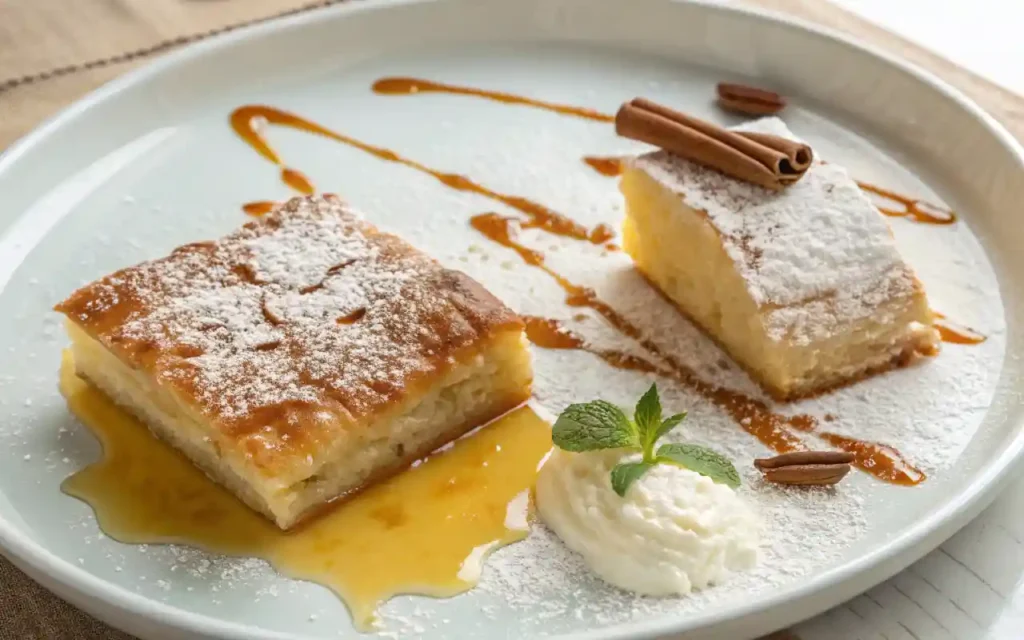
If baklava is the crispy king of Greek desserts, then galaktoboureko and bougatsa are the creamy counterparts that showcase the Greek mastery of custard and filo.
These desserts are built on a smooth semolina or cream-based custard, encased in layers of flaky filo and finished with syrup or powdered sugar. They are rich, indulgent, and deeply satisfying.
Galaktoboureko
This custard pie is baked in large trays, cut into squares, and drenched in lemon-scented syrup. The filling is made with semolina, milk, eggs, and citrus zest, creating a dense yet smooth texture.
Bougatsa
Bougatsa can be filled with custard, cheese, or meat, but the custard version is a sweet breakfast or snack pastry. It’s typically dusted with powdered sugar and cinnamon rather than syrup.
Vegan and Modern Twists
Both of these custard pastries have been adapted into dairy-free and plant-based forms using almond milk, coconut oil, or semolina thickeners.
- Explore the textures and traditions in
→ Galaktoboureko vs Bougatsa - Learn about vegan adaptations in
→ Top 5 Greek Vegan Desserts
Related Also:
→ Visit our Custards and Filo Sweets cluster for more creamy variations and filo-handling tips.
Desserts Tied to Holidays and Celebrations
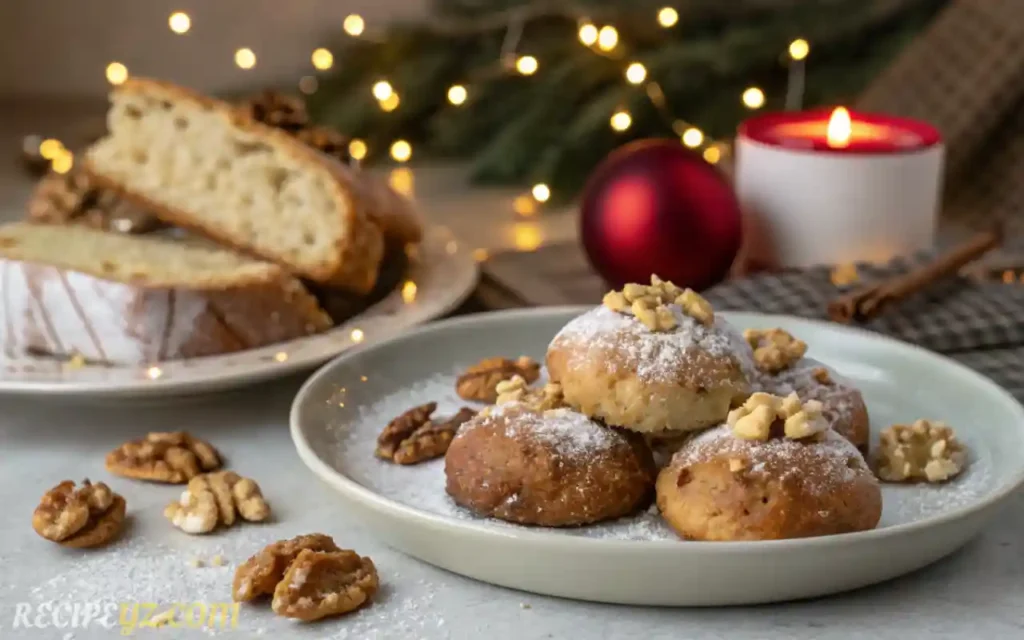
In Greek culture, sweets are not just about taste—they carry meaning, symbolism, and tradition. Certain desserts are prepared and served only during specific holidays, and their presence marks the rhythm of the Greek year.
Easter Traditions
- Tsoureki: Braided sweet bread flavored with mahlab and decorated with red eggs to symbolize rebirth
- Galaktoboureko: Often served after the Easter feast, a celebration of rich, post-Lenten ingredients
- Koulourakia: Butter-based twist cookies prepared during Holy Week
Christmas and Winter Festivities
- Melomakarona: Orange-scented honey cookies topped with crushed walnuts
- Kourabiedes: Almond shortbread cookies dusted with powdered sugar, symbolic of joy and purity
- Diples: Rolled and fried filo spirals soaked in syrup
Wedding, Baptism, and Name-Day Sweets
- Amygdalota: Almond cookies shaped like pears or balls, common at weddings
- Pasteli: Sesame and honey bars often handed out during large gatherings
→ See the full breakdown in
Best Greek Desserts for Festive Occasions
Related Cluster:
→ Explore more seasonal sweets in the Greek Desserts for Holidays and Health cluster.
Section 7: Greek Vegan & Fasting-Friendly Treats
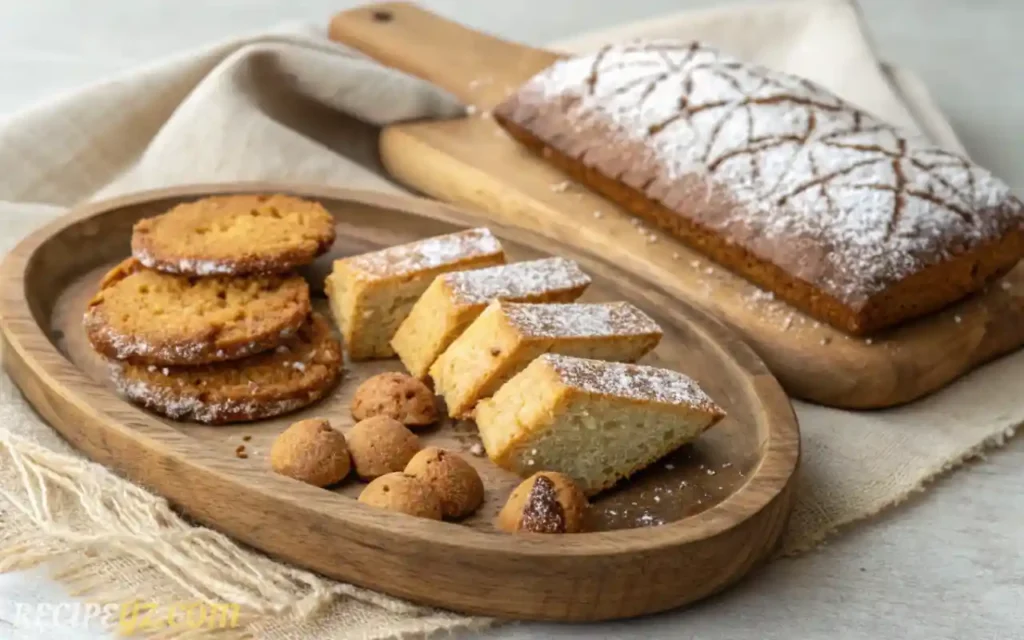
Many people are surprised to learn how naturally plant-based Greek desserts can be. Thanks to the long-standing influence of Orthodox Christian fasting periods, Greek cuisine includes a wide variety of sweets made without dairy, eggs, or animal products.
These desserts are often labeled “Lenten,” and they’re deeply rooted in Greek home cooking—even if they weren’t originally called “vegan.”
Fasting-Friendly Favorites
- Halva: A semolina-based dessert cooked with olive oil, sugar syrup, and spices
- Melomakarona (vegan version): Made with olive oil and orange juice, often enjoyed during fasting seasons
- Tahinopita: Sesame tahini cake that’s both rich and egg-free
- Pasteli: Sesame and honey bars naturally free from dairy and eggs
- Fruit-based spoon sweets: Preserved in syrup, often made in fasting households
These desserts are not only delicious and symbolic—they’re also ideal for those seeking plant-based or healthier alternatives to cream- and butter-rich pastries.
→ Explore the full list in
Top 5 Greek Vegan Desserts You Can Make Easily
→ Also see: Nutritional Breakdown of Popular greece desserts
Regional Specialties – Cretan, Island, and Northern Delights

While some greek dessert recipes are known nationwide, others are fiercely local—deeply tied to geography, seasonal harvests, and family tradition. These regional sweets often go unnoticed outside their origin towns but are treasured staples within them.
Cretan Highlights
- Kalitsounia: Small sweet cheese pastries with cinnamon or orange zest
- Xerotigana: Fried filo spirals drizzled with honey and sesame, especially during weddings and Easter
Island-Inspired Sweets
- Amygdalota (Cyclades, Chios, Hydra): Almond cookies often flavored with rosewater or citrus
- Pasteli: Found across multiple islands, combining sesame and honey into chewy snack bars
- Moustalevria: Grape must pudding made during wine harvests, especially in the Peloponnese and Santorini
Northern Greece and Thessaloniki
- Trigona Panoramatos: Syrup-soaked custard-filled triangle pastries
- Politiko Karydopita: A walnut cake influenced by Constantinopolitan Greek recipes
These desserts showcase how each region expresses Greek identity differently—through texture, ingredient use, and occasion.
→ Dive deeper into the diversity in
Regional Greek Dessert You’ve Probably Never Heard Of
Modern Innovations and Fusion Sweets
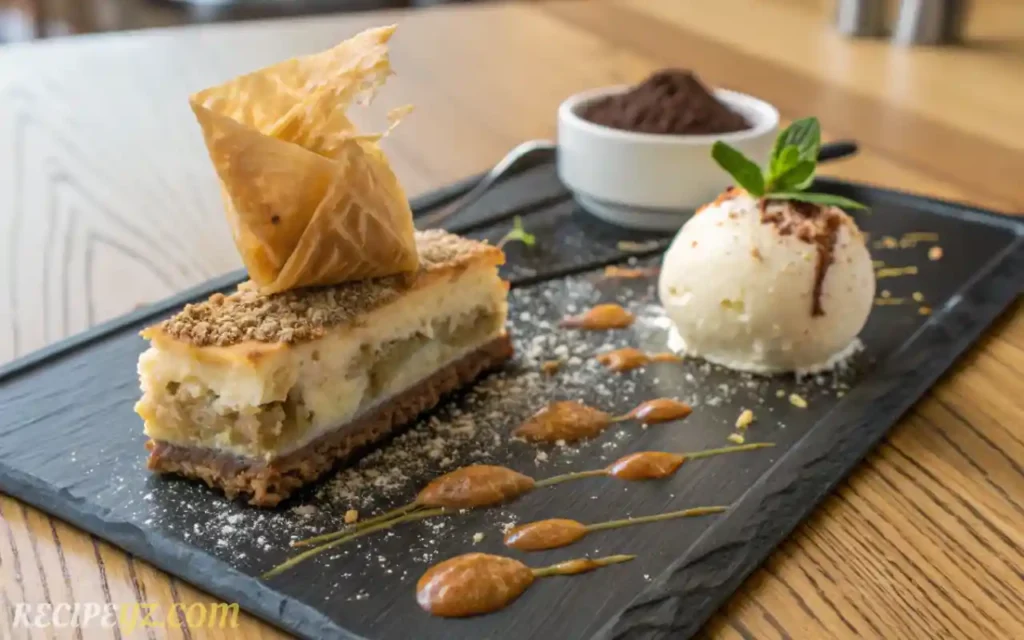
While tradition is at the heart of Greek dessert culture, a new wave of chefs and home bakers is breathing fresh life into classic recipes. These modern ancient greek desserts preserve beloved flavors—like honey, nuts, and semolina but remix the format, texture, and presentation.
Trending Reinventions
- Baklava Cheesecake: A rich, creamy dessert combining cheesecake with crushed baklava layers and filo shards
- Ouzo Sorbet: A refreshing adult treat that pairs anise liqueur with citrus or mint
- Loukoumades with a Twist: Filled with chocolate, served with gelato, or topped with creative sauces like tahini caramel
- Vegan Galaktoboureko: Made with almond milk and olive oil instead of dairy-based custard
These desserts aren’t just creative—they’re also shareable, visually striking, and adapted for dietary trends without losing their roots.
→ See more in
Modern Greek Dessert Recipes with a Twist
Dessert and Drink Pairings

In Greek tradition, dessert isn’t just about the sweet—it’s about what you serve with it. From strong coffee to anise-scented ouzo, the right drink pairing can balance syrupy pastries, enhance delicate flavors, and elevate the entire experience.
Pairing Classics
- Baklava + Greek Coffee: The bitter, earthy flavor of unfiltered coffee cuts through baklava’s richness
- Melomakarona + Vinsanto or Mavrodaphne: Sweet wines bring out the cookie’s citrus and spice notes
- Loukoumi + Ouzo: The soft chewiness of loukoumi (Greek-style Turkish delight) pairs well with ouzo’s licorice character
- Galaktoboureko + Rakomelo: A warm honey-spiced spirit pairs beautifully with creamy custard pastries
Entertaining Tips
- Serve small pours of wine or digestifs alongside miniature dessert portions
- Offer Greek mountain tea or herbal infusions with fasting-friendly or fruit-based desserts
- Use traditional serving ware to heighten the cultural experience
→ Explore our full pairing guide:
Pairing Greek Desserts with Traditional Drinks
Where to Buy Greek Desserts Online
Craving baklava but nowhere near a Greek bakery? You’re not alone. Fortunately, many Greek bakeries and specialty stores now offer nationwide and international shipping, making it easier than ever to enjoy authentic desserts at home—or gift them to someone else.
Trusted Online Sources
- Artopolis Bakery (USA): Offers classic baklava, galaktoboureko, and tsoureki loaves
- Yiayia’s Market: Sells curated Greek dessert boxes for holidays and name days
- Greekshops.com: Carries packaged cookies and branded Greek confections
- Daily Greek: Features regional specials like pasteli, kalitsounia, and spoon sweets
What to Expect
- Most items are shipped vacuum-sealed or bakery-boxed
- Syrupy desserts like baklava and galaktoboureko ship well and stay fresh up to a week
- Fragile cookies like kourabiedes may require express shipping to preserve texture
- Prices range from $15 to $60+, depending on quantity and packaging
Gifting Ideas
Many of these shops offer customizable dessert boxes ideal for:
- Birthdays
- Weddings
- Name days
- Religious holidays
→ Full guide: Where to Buy Authentic Greek Desserts Online
Ingredient Deep Dive – Honey, Nuts, and Filo Mastery
At the heart of nearly every Greek dessert are three key ingredients—honey, nuts, and filo dough. Each contributes not only to taste and texture but also to the symbolism and sustainability of greek traditional desserts baking.
Honey: The Sweet Backbone
Greek honey is more than just a sweetener—it’s a cultural staple. Traditionally harvested from thyme-fed bees, it brings floral, herbal complexity to desserts like:
- Baklava
- Melomakarona
- Diples
- Spoon sweets (Glyka tou koutaliou)
Honey is also symbolic of health and prosperity, especially in wedding and holiday recipes.
Nuts: Texture and Earthiness
Nuts add protein, crunch, and flavor depth to many pastries. Regional variation affects which nuts are used:
- Walnuts: Common in baklava and karydopita
- Almonds: Found in amygdalota and kourabiedes
- Pistachios: Popular in baklava variants and modern sweets
They’re often spiced with cinnamon or clove and used in layers or as toppings.
Filo Dough: Technique Meets Tradition
Filo (or phyllo) is a hallmark of Greek dessert craft. Paper-thin and delicate, it demands patience and skill.
Tips:
- Keep it covered with a damp towel to prevent drying
- Brush each layer generously with butter or oil
- Bake until golden and crisp, then add syrup for contrast
Mastering these ingredients is key to creating desserts that are authentic, balanced, and irresistibly Greek.
Health and Nutrition Considerations
While greek sweets are known for their richness, they also offer opportunities for wholesome indulgence. Many traditional recipes use natural sweeteners, plant-based fats, and nutrient-dense ingredients, aligning with the principles of the Mediterranean diet.
Healthier Ingredients in Traditional Sweets
- Olive oil: Replaces butter in many recipes like melomakarona and halva
- Honey: Used instead of refined sugar, adds antioxidants and complexity
- Nuts and seeds: Offer healthy fats, protein, and fiber
- Semolina: A lower-glycemic flour alternative in cakes and custards
Lower-Sugar and Plant-Based Options
Many desserts tied to fasting traditions are vegan by design, and others can be modified with simple swaps:
- Use maple syrup or agave in place of honey for vegan-friendly sweets
- Substitute whole wheat or almond flour for refined flours in cookies
- Reduce syrup quantity or pour it over cooled pastries to control absorption
Calorie and Sugar Snapshot
- Baklava: ~290–330 cal per square, high sugar
- Melomakarona: ~160–200 cal per cookie, moderate sugar
- Halva: ~180–220 cal per slice, made without dairy or eggs
→ For a full breakdown of nutrition per dessert, see:
Nutritional Breakdown of Popular Greek Desserts
Hosting the Ultimate Greek Dessert Night
There’s no better way to share the joy of Greek desserts than by hosting a dessert-focused gathering. Whether you’re planning a casual tasting evening or a formal celebration, Greek sweets offer a balance of flavor, texture, and cultural storytelling.
What to Serve
Build a spread with variety in mind:
- One syrupy dessert (e.g., baklava or galaktoboureko)
- One dry cookie (e.g., kourabiedes or koulourakia)
- One creamy or custard item (e.g., bougatsa or revani)
- One fruit-based or nut bar (e.g., spoon sweets or pasteli)
Add small bowls of pistachios, dried fruits, and fresh grapes to cleanse the palate between bites.
Drinks to Pair
- Greek coffee for baklava or rich pastries
- Vinsanto or Muscat wine for honey-based cookies
- Rakomelo or ouzo to finish with warmth
Serving Tips
- Use small dessert plates and serve items in bite-size portions
- Set the mood with bouzouki music, linen napkins, and subtle Mediterranean décor
- Offer printed menus or cards with dessert names and origins
This kind of event is perfect for introducing guests to Greek culture—or celebrating it with those who know it best.
Conclusion – Embracing the Sweet Spirit of Greece
Greek desserts are more than just culinary pleasures—they are cultural expressions of generosity, celebration, and connection. Whether shared during holidays, served at weddings, or gifted on name days, these sweets carry stories of family, faith, and resilience.
From the crisp layers of baklava to the warm softness of loukoumades, each bite connects you to centuries of tradition and innovation. Whether you’re making them at home, enjoying them abroad, or ordering online, Greek desserts offer a flavorful gateway into Mediterranean life. Discover must-try Greek desserts featured on Greek Boston’s website.
We hope this guide has inspired you to explore the richness of Greek sweets—whether through recipes, history, regional discoveries, or modern twists. Don’t just taste them—live them, share them, and celebrate them.
→ Return to the beginning or explore more in our Complete Greek Dessert Collection
FAQs About Greek Desserts
How to Make Greek Dessert Baklava?
To make baklava, start with layers of thin phyllo dough brushed with melted butter. Add a mixture of chopped nuts like walnuts or pistachios between layers. Once layered, bake until golden and crisp. Immediately after baking, pour a warm honey syrup flavored with cinnamon and lemon over the baklava, allowing it to soak in and sweeten the dessert. For a detailed guide, you can visit the Greek dessert baklava recipe page.
Is Baklava a Greek Dessert?
Baklava is widely considered a traditional greek dessert, though it has roots in various Middle Eastern cuisines. Over centuries, it became strongly associated with Greek culture and is a staple at celebrations and festivals. Today, baklava remains one of the most iconic greek desserts worldwide.
How to Make Greek Desserts?
Greek desserts typically involve simple ingredients like nuts, honey, yogurt, and phyllo pastry. The key is layering textures and balancing sweetness with aromatic spices. Whether you’re making baklava, kataifi, or yogurt-based treats, start with fresh ingredients and follow classic preparation methods. The Greek dessert variations page offers many easy-to-follow recipes.
How to Make Greek Yogurt Dessert?
Greek yogurt desserts are easy to prepare by combining thick yogurt with honey, nuts, and fresh fruits. You can also make frozen yogurt treats or parfaits layered with granola. These desserts are quick to assemble and ideal for a refreshing finish to any meal. Explore recipes on the Greek yogurt recipes page for inspiration.
Is Greek Yogurt a Good Dessert?
Yes, Greek yogurt is an excellent dessert option. It’s rich in protein and probiotics, offering a healthy alternative to heavier sweets. Its creamy texture and tangy flavor complement fruits, nuts, and honey well, making it both nutritious and delicious.
What are famous Greek desserts?
Some famous Greek desserts include Baklava (a sweet pastry made with layers of filo dough, nuts, and honey), Galaktoboureko (a custard-filled pastry wrapped in filo dough and soaked in syrup), Loukoumades (fried dough balls drizzled with honey syrup), Kataifi (shredded filo dough filled with nuts and soaked in syrup), and Bougatsa (a pastry filled with custard or cheese).
What desserts use Greek yogurt?
Greek Yogurt Parfaits: Layers of Greek yogurt with honey, fruits, and granola.
Greek Yogurt Cheesecake: A lighter version of traditional cheesecake using Greek yogurt as a base.
Greek Yogurt Panna Cotta: A creamy dessert made with Greek yogurt, cream, and gelatin.
Greek Yogurt with Honey and Nuts: A simple, yet delicious dessert of Greek yogurt topped with honey and crushed nuts like walnuts or pistachios.
What is a traditional Greek pastry?
Baklava is perhaps the most famous Greek pastry, but others include Kataifi (shredded filo dough), Bougatsa (a pastry filled with custard or cream), and Tiropita (a savory pastry filled with feta cheese).
What is a traditional Greek dessert with custard?
Galaktoboureko is a traditional Greek dessert that combines custard and filo dough. The custard is made from semolina, milk, sugar, and eggs, and it’s baked between layers of crispy filo dough, then soaked in syrup.
For more recipes and tips, be sure to explore the full range of greek dessert delights on Recipeyz.




3 thoughts on “Greek Desserts: Discover Traditional Flavors and Easy Recipes”